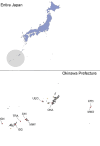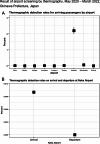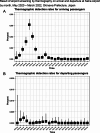Assessment of fever screening at airports in detecting domestic passengers infected with SARS-CoV-2, 2020-2022, Okinawa prefecture, Japan
- PMID: 38816697
- PMCID: PMC11138063
- DOI: 10.1186/s12879-024-09427-5
Assessment of fever screening at airports in detecting domestic passengers infected with SARS-CoV-2, 2020-2022, Okinawa prefecture, Japan
Erratum in
-
Correction: Assessment of fever screening at airports in detecting domestic passengers infected with SARS-CoV-2, 2020-2022, Okinawa prefecture, Japan.BMC Infect Dis. 2024 Jun 23;24(1):621. doi: 10.1186/s12879-024-09533-4. BMC Infect Dis. 2024. PMID: 38910239 Free PMC article. No abstract available.
Abstract
Background: While airport screening measures for COVID-19 infected passengers at international airports worldwide have been greatly relaxed, observational studies evaluating fever screening alone at airports remain scarce. The purpose of this study is to retrospectively assess the effectiveness of fever screening at airports in preventing the influx of COVID-19 infected persons.
Methods: We conducted a retrospective epidemiological analysis of fever screening implemented at 9 airports in Okinawa Prefecture from May 2020 to March 2022. The number of passengers covered during the same period was 9,003,616 arriving at 9 airports in Okinawa Prefecture and 5,712,983 departing passengers at Naha Airport. The capture rate was defined as the proportion of reported COVID-19 cases who would have passed through airport screening to the number of suspected cases through fever screening at the airport, and this calculation used passengers arriving at Naha Airport and surveillance data collected by Okinawa Prefecture between May 2020 and March 2021.
Results: From May 2020 to March 2021, 4.09 million people were reported to pass through airports in Okinawa. During the same period, at least 122 people with COVID-19 infection arrived at the airports in Okinawa, but only a 10 suspected cases were detected; therefore, the capture rate is estimated to be up to 8.2% (95% CI: 4.00-14.56%). Our result of a fever screening rate is 0.0002% (95%CI: 0.0003-0.0006%) (10 suspected cases /2,971,198 arriving passengers). The refusal rate of passengers detected by thermography who did not respond to temperature measurements was 0.70% (95% CI: 0.19-1.78%) (4 passengers/572 passengers).
Conclusions: This study revealed that airport screening based on thermography alone missed over 90% of COVID-19 infected cases, indicating that thermography screening may be ineffective as a border control measure. The fact that only 10 febrile cases were detected after screening approximately 3 million passengers suggests the need to introduce measures targeting asymptomatic infections, especially with long incubation periods. Therefore, other countermeasures, e.g. preboarding RT-PCR testing, are highly recommended during an epidemic satisfying World Health Organization (WHO) Public Health Emergency of International Concern (PHEIC) criteria with pathogen characteristics similar or exceeding SARS-CoV-2, especially when traveling to rural cities with limited medical resources.
Keywords: Airport; COVID-19; Fever screening; Prevention.
© 2024. The Author(s).
Conflict of interest statement
The authors declare that they have no competing interests.
Figures




Similar articles
-
Universal screening for SARS-CoV-2 infection: a rapid review.Cochrane Database Syst Rev. 2020 Sep 15;9(9):CD013718. doi: 10.1002/14651858.CD013718. Cochrane Database Syst Rev. 2020. PMID: 33502003 Free PMC article.
-
Fever screening during the influenza (H1N1-2009) pandemic at Narita International Airport, Japan.BMC Infect Dis. 2011 May 3;11:111. doi: 10.1186/1471-2334-11-111. BMC Infect Dis. 2011. PMID: 21539735 Free PMC article.
-
Assessing exit screening of SARS-CoV-2 in Japan: an analysis of the airport screening data of passengers from the United Kingdom, 2020-2022.BMC Infect Dis. 2024 Sep 12;24(1):962. doi: 10.1186/s12879-024-09894-w. BMC Infect Dis. 2024. PMID: 39267012 Free PMC article.
-
Air Passengers' Risk of SARS-CoV-2 Infection With a 14-Day Quarantine and Accuracy Assessment of a Symptom-based Screening System at an Airport.J Prev Med Public Health. 2025 Jan;58(1):72-82. doi: 10.3961/jpmph.24.517. Epub 2024 Nov 3. J Prev Med Public Health. 2025. PMID: 39638300 Free PMC article.
-
A rapid review of the effectiveness of screening practices at airports, land borders and ports to reduce the transmission of respiratory infectious diseases such as COVID-19.S Afr Med J. 2020 Oct 12;110(11):1105-1109. S Afr Med J. 2020. PMID: 33403987 Review.
Cited by
-
Correction: Assessment of fever screening at airports in detecting domestic passengers infected with SARS-CoV-2, 2020-2022, Okinawa prefecture, Japan.BMC Infect Dis. 2024 Jun 23;24(1):621. doi: 10.1186/s12879-024-09533-4. BMC Infect Dis. 2024. PMID: 38910239 Free PMC article. No abstract available.
References
-
- COVID-19. Current Japanese Border Measures, Ministry of Health, Labour and Welfare, Japan. [cited 2023 July/6] https://www.mhlw.go.jp/stf/covid-19/bordercontrol.html
-
- World Health Organization. Statement on the fifteenth meeting of the IHR. (2005) Emergency Committee on the COVID-19 pandemic. 5 May 2023. [cited 2023 July/6] https://www.who.int/news/item/05-05-2023-statement-on-the-fifteenth-meet...
MeSH terms
Grants and funding
LinkOut - more resources
Full Text Sources
Medical
Miscellaneous

